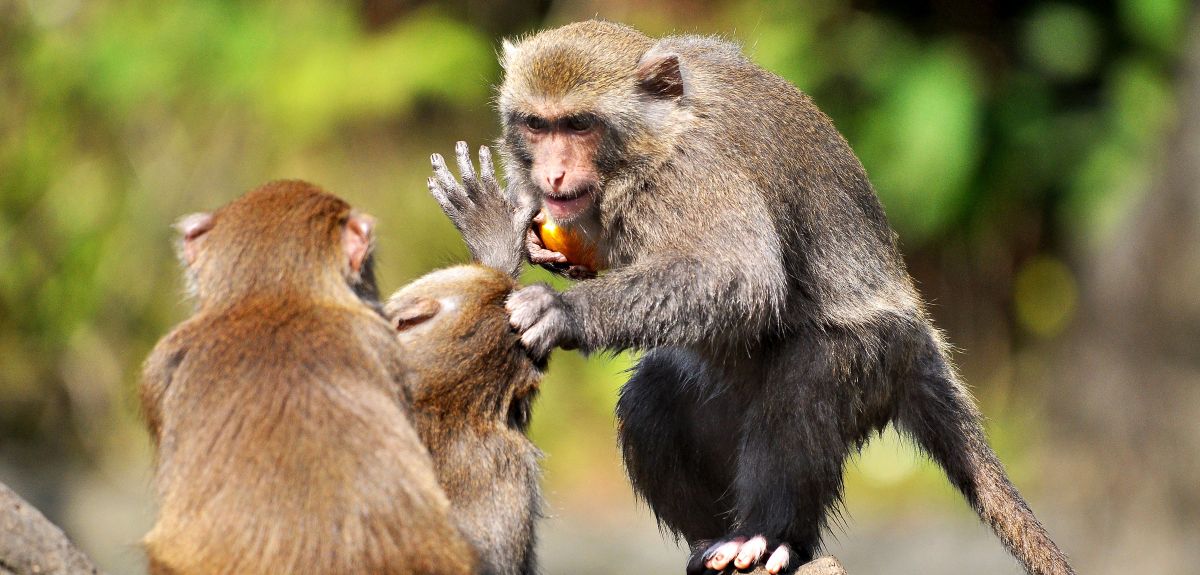
Brain link to primacy in primates
The size of different brain regions relates to our status in the social hierarchies we encounter every day.
The importance of social rank is something we all learn at an early age.
Life on the lowest rung can be stressful, but life at the top also requires careful acts of balancing and coalition forming.
In non-human primates, social dominance influences access to food and mates. In humans, social hierarchies influence our performance everywhere from school to the workplace and have a direct influence on our well-being and mental health. However, we know very little about the relationship between these social ranks and brain function.
New research, conducted at the University of Oxford, has revealed differences between individual primate's brains which depend on their social status. The more dominant you are, the bigger some brain regions are. If your social position is more subordinate, other brain regions are bigger.
The research, led by Dr MaryAnn Noonan of the Decision and Action Laboratory in the Department of Experimental Psychology, determined the position of 25 macaque monkeys in their social hierarchies. The team then analysed non-invasive scans of the monkey's brains which had been taken as part of other ongoing University research programs. The findings, published in the open access journal PLOS Biology, show that brain regions in one neural circuit are larger in more dominant animals. Previous research has shown that these regions are involved in learning and in processing social and emotional information.
The MRI scans also revealed that another circuit of brain regions, which collectively can be called the striatum, were found to be larger in more subordinate animals. The striatum is known to play a complex but important role in learning the value of our choices and actions.
The study further reports that the brain's activity, not just its structure, varies with position in the social hierarchy. The researchers found that the strength with which activity in some of these areas was coupled together also related to social status. Collectively, these results mean that social status is not only reflected in the brain’s hardware, it is also connected to differences in the brain's software, or communication patterns.
The team also found that the size of another set of brain regions correlated not only with social status but also with the size of the animal's social group. The macaque groups ranged between one and seven individuals. The research showed that grey matter in regions involved in social cognition correlated with both group size and social status. Previous research has shown that these regions are important for a variety of social behaviours. These include interpreting facial expressions or physical gestures, understanding the intentions of others and predicting their behaviour.
'This finding may reflect the fact that social status in macaques depends not only on the outcome of competitive social interactions but on social bonds formed that promote coalitions,' said Professor Matthew Rushworth, the head of the Decision and Action Laboratory in Oxford. 'The correlation with social group size and social status suggests this set of brain regions may coordinate behaviour that bridges these two social variables.'
The reasons for the identified brain differences remain unclear, particularly whether they are present at birth or result from social differences. Dr Noonan said: 'One possibility is that the demands of a life in a particular social position use certain brain regions more frequently and as a result those areas expand to step up to the task. Alternatively, it is possible that people born with brains organised in a particular way tend towards certain social positions. In all likelihood, both of these mechanisms will work together to produce behaviour appropriate for the social context.'
Social status also changes over time and in different contexts. Dr Noonan explained: 'While we might be top-dog in one circle of friends, at work we might be more of a social climber. The fluidity of our social position and how our brains adapt our behaviour to succeed in each context is the next exciting direction for this area of research.'
The study was supported by funding from the Medical Research Council, the Wellcome Trust and the National Institute of Health Research.
 Logged tropical forests are still valuable for biodiversity, study finds
Logged tropical forests are still valuable for biodiversity, study finds
 Pioneering new mathematical model could help protect privacy and ensure safer use of AI
Pioneering new mathematical model could help protect privacy and ensure safer use of AI
 New study reveals link between head injuries and viruses in Alzheimer's Disease
New study reveals link between head injuries and viruses in Alzheimer's Disease
 Major new footprint discoveries on Britain’s ‘dinosaur highway’
Major new footprint discoveries on Britain’s ‘dinosaur highway’
 New Year Honours 2025
New Year Honours 2025
 Brain area unique to humans linked to cognitive powers
Brain area unique to humans linked to cognitive powers